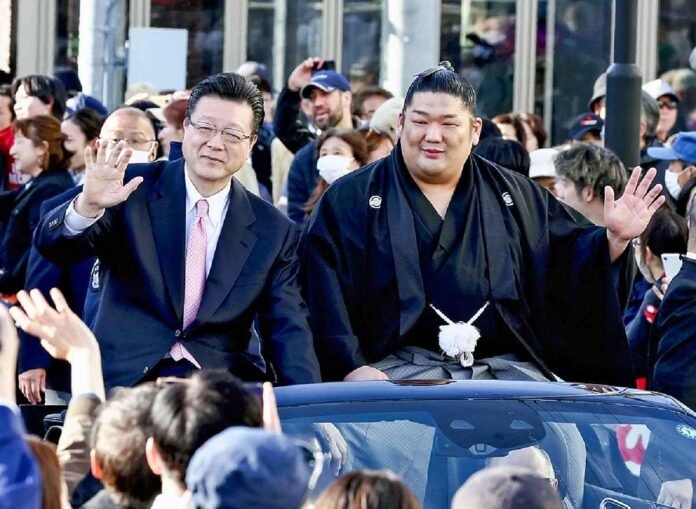Takerufuji, right, and his stablemaster Isegahama take part in a parade in Takerufuji’s hometown of Goshogawara, Aomori Prefecture, on May 1.
16:25 JST, May 29, 2024
For a sumo wrestler who has won a championship, the two highest honors are receiving the Emperor’s Cup and the victory parade afterwards. Riding in an open-top car, with a flag bearer at their side, they circle the vicinity of the Ryogoku Kokugikan or regional tournament venues. The parade serves to showcase the champion to those who were unable to attend the tournament, and it is a beloved sight for the many fans who line the streets to celebrate his victory.
Unfortunately, Takerufuji had to withdraw from the Summer Grand Sumo Tournament this month due to a leg injury. However, after becoming the first newly promoted wrestler to become champion in 110 years at the spring tournament in March, the final day featured an official parade around the Osaka Prefectural Gymnasium, also known as Edion Arena Osaka.
There was also a triumphal parade in his hometown of Goshogawara, Aomori Prefecture on May 1. As many as 55,000 people lined the streets, according to the city’s announcement.
Takerufuji expressed his gratitude, saying, “Thanks to all of you, I was able to seize this victory.”
There are many anecdotes about victory parades of the past.
Sekiwake Asashio in the 1956 spring tournament and yokozuna Wakanohana in the 1959 summer basho both won by reversal, so they had no time to prepare formal clothes. They drove in the open-top car wearing only a mawashi loincloth. These so-called ‘naked parades’ became a hot topic. There are many examples of wrestlers holding parades in their hometowns, such as Takerufuji.
Ozeki Kotoshogiku (now stablemaster Hidenoyama) became the first Japanese-born wrestler to win the Emperor’s Cup in 10 years at the 2016 New Year Grand Sumo Tournament. In March of the same year, he held a water parade, riding a boat through the canals of his hometown of Yanagawa, Fukuoka Prefecture, and was cheered on by locals. These types of celebrations are unique to sumo, with wrestlers maintaining close ties to their hometown.
Victory parades are often held during the off-season in professional baseball and other sports, but since sumo has six champions per year, one for each tournament, many people associate parades with sumo.
It’s a blissful moment that every wrestler dreams of. Championship-winning wrestlers have unanimously said that it is a joyful time, blowing away the fatigue of the 15-day tournament.
— Kamimura is a sumo expert.



